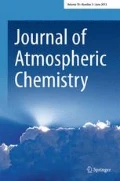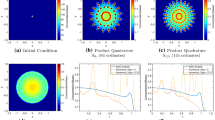Abstract
We present a fast and well documented two-stream algorithm for radiative transfer and particle transport in vertically inhomogeneous, layered media. The physical processes considered are internal production (emission), scattering, absorption, and Lambertian reflection at the lower boundary. The medium may be forced by internal sources as well as by parallel or uniform incidence at the top boundary. This two-stream algorithm is based on a general purpose multi-stream discrete ordinate algorithm released previously. It incorporates all the advanced features of this well-tested and unconditionally stable algorithm, and includes two new features: (i) corrections for spherical geometry, and (ii) an efficient treatment of internal sources that vary rapidly with depth. It may be used to compute fluxes, flux divergences and mean intensities (actinic fluxes) at any depth in the medium. We have used the numerical code to investigate the accuracy of the two-stream approximation in vertically inhomogeneous media. In particular, computations of photodissociation and warming/cooling rates and surface fluxes of ultraviolet and visible radiation for clear, cloudy and aerosol-loaded atmospheres are presented and compared with results from multi-stream computations. The O3 +hv → O(1D) + O2 and O3 +hv → O(3P) + O2 photodissociation rates were considered for solar zenith angles between 0.0–70.0° and surface albedos in the range 0.0–1.0. For small and moderate values of the solar zenith angle and the surface albedo the error made by the two-stream approximation is generally smaller, <10%, than the combined uncertainty in cross sections and quantum yields. Surface ultraviolet and visible fluxes were calculated for the same range of solar zenith angles and surface albedos as the photodissociation rates. It was found that surface ultraviolet and visible fluxes may be calculated by the two-stream approximation with 10% error or less for solar zenith angles less than 60.0° and surface albedos less than 0.5. For large solar zenith angles and/or large surface albedos, conditions typical at high latitudes, the error made by the two-stream approximation may become appreciable, i.e. 20% or more for the photodissociation rates in the lower stratosphere and for ultraviolet and visible surface fluxes for large surface albedos. The two-stream approximation agrees well with multi-stream results for computation of warming/cooling rates except for layers containing cloud and aerosol particles where errors up to 10% may occur. The numerical code provides a fast, well-tested and robust two-stream radiative transfer program that can be used as a ‘software tool’ by aeronomers, atmospheric physicists and chemists, climate modellers, meteorologists, photobiologists and others concerned with radiation or particle transport problems. Copies of the FORTRAN77 program are available to interested users.
Similar content being viewed by others
References
Allen, M. and Frederick, J. E., 1982, Effective photodissociation cross sections for molecular oxygen and nitric oxide in the Schumann-Runge bands,J. Atmos. Sci. 39, 2066.
Anderson, G. P., Clough, S. A., Kneizys, F. X., Chetwynd, J. H., and Shettle, E. P., 1987, AFGL Atmospheric Constituent Profiles (0–120 km), AFGL-TR-86-0110, AFGL (OPI), Hanscom AFB, MA 01736.
Bohren, C. F., 1987, Multiple scattering of light and some of its observable consequences,American J. Phys. 55, 524–533.
Brühl, C. and Crutzen, P. J., 1989, On the disproportionate role of tropospheric ozone as a filter against solar UV-B radiation,Geophys. Res. Lett. 16, 703–706.
Chandrasekhar, S., 1960,Radiative Transfer (Dover, New York).
Dahlback, A., Henriksen, T., Larsen, S. H. H., and Stamnes, K., 1989, Biological UV-doses and the effect of an ozone layer depletion,Photochemistry and Photobiology 49, 621.
Dahlback, A. and Stamnes, K., 1991, A new spherical model for computing the radiation field available for photolysis and heating at twilight,Planet. Space Sci. 39, 671–683.
DeMore, W. B.et al., 1992, Chemical kinetics and photochemical data for use in stratospheric modeling, Evaluation number 10, JPL publ. 92–20. Jet Propul. Lab., Pasadena, Calif.
Dongerra, J. J., Moler, C. B., Bunch, J. R., and Stewart, G. W., 1979, LINPACKUser's Guide, (SIAM, Philadelphia).
Frederick, J. E. and Lubin, D., 1988, The budget of biologically active ultraviolet radiation in the Earth-Atmosphere system,J. Geophys. Res. 93, 3825–3832.
Goody, R. M. and Yung, Y. L., 1989,Atmospheric Radiation: Theoretical Basis, Oxford University Press, New York.
Hansen, J. and Lacis, A. A., 1990, Sun and dust versus greenhouse gases: An assessment of their relative roles in global climate change,Nature 346, 713–719.
Hu, Y. X. and Stamnes, K., 1993, An accurate parameterization of the radiative properties of water clouds suitable for use in climate models,J. Clim. 6, 728–742.
Joseph, J., Wiscombe, W. J., and Weinman, J. A., 1976, The delta-Eddington approximation for radiative flux transfer,J. Atmos. Sci. 33, 2452–2459.
King, M. D. and Harshvardhan, 1986, Comparative accuracy of selected multiple scattering approximations,J. Atmos. Sci. 43, 784–801.
Kylling, A., 1992, Radiation transport in cloudy and aerosol loaded atmospheres, Ph.D. thesis, University of Alaska-Fairbanks.
Kylling, A. and Stamnes, K., 1992, Efficient yet accurate solution of the linear transport equation in the presence of internal sources: The exponential-linear approximation,J. Comp. Phys. 102, 265–276.
Kylling, A., 1994, uvspec, a program for calculation of diffuse and direct uv and visible fluxes on horizontal surfaces, available by anonymous ftp to kaja.gi.alaska.edu, cd pub/arve.
Lacis, A., Oinas, A. and Oinas, V., 1991, A description of the correlatedk distribution method for modeling nongray gaseous absorption, thermal emission, and multiple scattering in vertically inhomogenous atmospheres,J. Geophys. Res. 96, 9027–9063.
Lenoble, J., 1985,Radiative Transfer in Scattering and Absorbing Atmospheres: Standard Computational Procedures, A. Deepak, Hampton, Va.
Madronich, S., 1987, Photodissociation in the atmosphere: 1. Actinic flux and the effects of ground albedo and clouds,J. Geophys. Res. 92, 9740–9752.
Madronich, S. and Weller, G., 1990, Numerical integration errors in calculated tropospheric photodissociation rate coefficients,J. Atmos. Chem. 10, 289–300.
Meador, W. E. and Weaver, W. R., 1980, Two-stream approximations to radiative transfer in planetary atmospheres: A unified description of existing methods and new improvements,J. Atmos. Sci. 37, 630–643.
Nagy, A. F. and Banks, P. M., 1970, Photoelectron fluxes in the ionosphere,J. Geophys. Res. 75, 6260–6270.
Rees, M. H.,Physics and chemistry of the upper atmosphere (Cambridge University Press, 1989).
Schaller, E., 1979, A delta-two-stream approximation in radiative flux calculations,Contrib. Atmos. Phys. 52, 17–26.
Shettle, E. P., 1989, Models of aerosols, clouds and precipitation for atmospheric propagation studies, in AGARD Conference Proceedings No. 454,Atmospheric propagation in the uv, visible, ir and mm-region and related system aspects.
Stamnes, K., 1981, On the two-stream approach to electron transport and thermalization,J. Geophys. Res. 86, 2408–2410.
Stamnes, K., 1982, Reflection and transmission by a vertically inhomogeneous planetary atmosphere,Planet. Space Sci. 30, 727–732.
Stamnes, K. and Conklin, P., 1984, A new multi-layer discrete ordinate approach to radiative transfer in vertically inhomogeneous atmospheres,J. Quant. Spectrosc. Radiat. Transfer 31, 273.
Stamnes, K. 1986, The theory of multiple scattering of radiation in plane-parallel atmospheres,Rev. Geophys. 24, 299–310.
Stamnes, K., Tsay, S.-C., Wiscombe, W., and Jayaweera, K., 1988, Numerically stable algorithm for discrete-ordinate-method radiative transfer in multiple scattering and emitting layered media,Applied Optics 27, 2502.
Stamnes, K., Lie-Svendsen, Ø., and Rees, M. H., 1991, The linear Boltzmann equation in slab geometry: Development and verification of a reliable and efficient solution,Planet. Space Sci. 39, 1435–1463.
Toon, O. B., McKay, C. P., and Ackerman, T. P., 1989, Rapid calculation of radiative heating rates and photodissociation rates in inhomogeneous multiple scattering atmospheres,J. Geophys. Res. 94, 16 287–16 301.
Turco, R. P., Whitten, R. C., and Toon, O. B., 1982, Stratospheric Aerosols: Observation and Theory,J. Geophys. Res. 20, 233–279.
Vetterling, W. T., Teukolsky, S. A., Press, W. H., and Flannery, B. P., 1985,Numerical Recipes: Example Book (FORTRAN), Cambridge University Press.
Wiscombe, W., 1977a, The delta-Eddington approximation for a vertically inhomogeneous atmosphere', NCAR Tech. Note NCAR/TN-121+STR.
Wiscombe, W., 1977b, The Delta-M method: Rapid yet accurate radiative flux calculations for strongly asymmetric phase functions,J. Atmos. Sci. 34, 1408.
World Meteorological Organization, 1986, Atmospheric Ozone 1985, Assessment of our understanding of the processes controlling its present distribution and changes,Rep. 16, Global Ozone Res. and Monit. Proj., Geneva, Switzerland.
Zdunkowski, W., Welch, R., and Korb, G., 1980, An investigation of the structure of typical two-stream methods for the calculation of solar fluxes and heating rates in clouds,Contribut. Atmos. Phys. 53, 147–165.
Author information
Authors and Affiliations
Rights and permissions
About this article
Cite this article
Kylling, A., Stamnes, K. & Tsay, S.C. A reliable and efficient two-stream algorithm for spherical radiative transfer: Documentation of accuracy in realistic layered media. J Atmos Chem 21, 115–150 (1995). https://doi.org/10.1007/BF00696577
Received:
Revised:
Issue Date:
DOI: https://doi.org/10.1007/BF00696577




